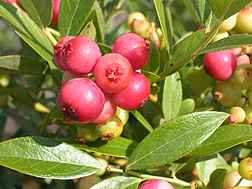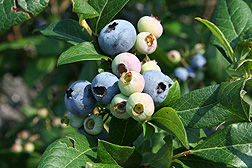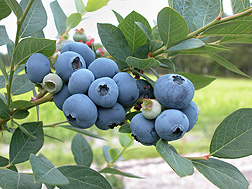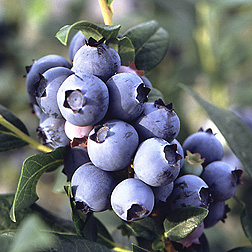Pink Lemonade, Razz, and More!
Wonderful Blueberries From ARS to You
|
|
Anyone who grows backyard blueberries knows that some of the berries may turn pink before they finally ripen to a familiar dusty blue.
When a Pink Lemonade blueberry is ripe and ready to eat, however, it is, in fact, pink.
Though not a first, this intriguing coloration is “still somewhat unusual” for a ripe, harvest-ready blueberry, according to Agricultural Research Service plant geneticist Mark K. Ehlenfeldt.
Ehlenfeldt has his laboratory, greenhouse, and test plots at the Philip E. Marucci Center for Blueberry and Cranberry Research and Extension in Chatsworth, New Jersey, about 60 miles south of Newark in the state’s pine barrens.
Here’s more about Pink Lemonade and a glimpse of several other interesting blueberries developed through the Chatsworth research.
Pink Lemonade: Pretty and Tasty
Pink Lemonade “may be the prettiest blueberry around,” says Ehlenfeldt. This plant bears moderate yields of firm, glossy, medium-sized berries, with a mild flavor that Ehlenfeldt describes as “sweet and flowery.” It ripens from mid-late to late season. In New Jersey, that’s usually mid to late July.
“Pink Lemonade is also a nice plant for landscaping,” Ehlenfeldt says. “It has shiny green leaves in spring and summer and dusky, reddish-brown twigs in winter.”
|
|
Ehlenfeldt says Pink Lemonade is suited for U.S. Department of Agriculture Plant Hardiness Zone 6—where the weather, on average, never gets colder than 0°F—and for milder regions.
Pink Lemonade resulted from the crossing of two parent plants—an experimental blueberry developed by Nicholi Vorsa, a Rutgers University scientist stationed at the Chatsworth center, and a commercial blueberry, Delite, which was developed by USDA and the University of Georgia. Ehlenfeldt crossed these two plants in 1991 and, in 1996, chose one of the offspring—designated as “Selection Number ARS 96-138”—for further testing.
While Ehlenfeldt was scrutinizing the plant’s performance in New Jersey test plots, colleague Chad E. Finn, a plant geneticist in the ARS Horticultural Crops Research Unit in Corvallis, Oregon, was evaluating it on the West Coast, in response to interest by the plant nursery industry in that region.
Based on that interest and the good scores that ARS 96-138 achieved in these evaluations, the scientists formally released the variety in 2005, assigning the selection number as its identifier. In 2007, to help build market identity for the plant, the researchers named it “Pink Lemonade.” In that same year, the novel blueberry garnered a “best new shrub” honor at the prestigious Far West Horticultural Show. You can find “Pink Lemonade” for sale in garden catalogs and on the web.
|
|
Razz: Its Flavor Will Surprise—and Please
Razz is a blueberry with a taste that’s rather surprising. Its name is a hint: Razz tastes quite a bit like a raspberry.
“The remarkable raspberry overtones make Razz unlike any other commercial blueberry that we know of,” says Ehlenfeldt.
Razz is a “rediscovered” blueberry. It was bred in 1934 by USDA’s first blueberry breeder, Frederick V. Coville. It was selected for further study by USDA scientist George M. Darrow and Rutgers plant breeder J.H. Clarke in 1941.
After that, it “just hung around for a long time,” says Ehlenfeldt. “It was considered unsuitable for large-scale commercial production because it was too soft for shipping or storing. And, although people appreciated its flavor, the berry was simply too different for the times.
“Eventually, several nurseries expressed an interest in growing and marketing it to backyard gardeners. We decided to test it here in New Jersey and released it in 2011.”
Razz produces good yields of medium to large berries that ripen in midseason. “In New Jersey, that is the end of June through the first week or two of July,” Ehlenfeldt says.
“Razz should do well in most places where northern highbush blueberries can be grown. Growers, pick-your-own farms, and backyard gardeners might want to give this specialty berry a try.”
|
|
Sweetheart: A Berry To Begin—and End—the Growing Season
Sweetheart may be the perfect plant for those who just can’t wait for the first blueberries of the growing season—and, of course, hate to see the season end.
That’s because Sweetheart meets both needs. It produces firm, delectable, medium to medium-large berries early in the season, about mid-June through the end of the month. Then, if the autumn is mild, Sweetheart may reflower and refruit, Ehlenfeldt says. “The autumn yield is not really large enough to be called a ‘second crop,’” he explains, “but it’s a nice treat at a time when most blueberry plants have long since stopped fruiting.” Late-season refruiting is “a somewhat unusual trait,” he notes.
Sweetheart berries have “a superior flavor that lasts, even in storage,” he says. That’s unlike some blueberries, which “begin to lose some flavor soon after they’ve been picked.”
Well suited for commercial growers, Sweetheart is “great for home gardens, too,” says Ehlenfeldt who, in 1996, made the cross that resulted in today’s Sweetheart plants. In 1999, he chose it—from among other candidate seedlings—for further study, continued testing it at Chatsworth through 2009, then formally released it as a named variety in 2010.
Sweetheart can be grown in USDA Plant Hardiness Zone 5—where temperatures usually won’t get colder than –10°F, on average—and in milder zones. What’s more, some preliminary studies “suggest that Sweetheart may also be hardy in regions colder than Zone 5,” says Ehlenfeldt.
Cara’s Choice: Outstanding Flavor
Cara’s Choice is “regarded by some blueberry aficionados as having the best flavor of any blueberry,” says Ehlenfeldt. “This is a very sweet, medium-sized blueberry, with a pleasant aroma.”
Even though its yields are only moderate—about 35 percent less than industry standards such as Bluecrop, for example—this berry nonetheless offers growers the significant advantage of keeping its quality while still on the bush. “That’s a plus,” notes Ehlenfeldt, “because it allows growers to distribute their harvests over a longer period of time.” Meanwhile, the berries’ sweetness tends to increase.
“The berries can stay on the plant for several weeks after ripening, without losing flavor or firmness,” he reports.
Best for Zone 6 and milder zones, this berry is ready for harvest in midseason.
Blueberry researcher Arlen D. Draper, formerly with USDA in Beltsville, Maryland, and now retired, made the cross that yielded today’s Cara’s Choice in the late 1970s and, in 1981, singled it out for further study. Since then, evaluations at the Atlantic Blueberry Company and at Variety Farms—both in Hammonton, New Jersey—by Draper; Ehlenfeldt; now-retired ARS scientists Gene J. Galletta and Allan W. Stretch; and Rutgers’s Vorsa led to the plant’s release in 2000.
Ehlenfeldt expects to have yet another superb blueberry ready to introduce in the near future.—By Marcia Wood, Agricultural Research Service Information Staff.
This research is part of Plant Genetic Resources, Genomics, and Genetic Improvement (#301) and Plant Diseases (#303), two ARS national programs described at www.nps.ars.usda.gov.
To reach the scientists featured in this article, contact Marcia Wood, USDA-ARS Information Staff, 5601 Sunnyside Ave., Beltsville, MD 20705-5129; (301) 504-1662.
"Pink Lemonade, Razz, and More! Wonderful Blueberries From ARS to You" was published in the September 2012 issue of Agricultural Research magazine.










